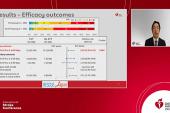Thrombectomy Advantage for Large-Core Strokes Widens Over 12 Months: TESLA
The findings suggest these types of patients continue to improve beyond 3-6 months and thus might benefit from longer rehab.

PHOENIX, AZ—After 1 year of follow-up, a significant benefit with thrombectomy on top of medical therapy for patients with large-core ischemic strokes has emerged in the TESLA trial, which fell shy of meeting its primary endpoint at an earlier time point.
The difference in functional outcomes in favor of thrombectomy versus medical therapy alone grew between 90 days and 1 year, Albert Yoo, MD, PhD (Texas Stroke Institute, Plano, TX), and Osama Zaidat, MD (Mercy Health, Toledo, OH), reported here at the International Stroke Conference (ISC).
A potential explanation “is continued recovery beyond 90 days in large-core patients,” Yoo said, indicating that this could have implications for future research and patient management.
“Longer-term follow-up may be needed for this population in further studies, and rehabilitation may be necessary for a longer period,” he said. Moreover, it could be that intra-arterial therapy is promoting long-term brain plasticity in this group, although that requires additional investigation, he said.
Multiple trials, including RESCUE-Japan LIMIT, SELECT2, and ANGEL-ASPECT, have found that thrombectomy improves outcomes in patients with large-core strokes, defined by an Alberta Stroke Program Early CT Score (ASPECTS) < 6. These types of patients had been excluded from the initial trials that established stroke thrombectomy as an effective treatment for acute ischemic stroke caused by large-vessel occlusions.
The main results of TESLA, presented last year at the at the European Stroke Organisation Conference (ESOC), missed its primary endpoint, with the Bayesian probability that thrombectomy was superior to medical management alone in terms of 90-day functional outcomes coming in at 0.957, short of the prespecified threshold of 0.975. Some secondary analyses pointed to a benefit, however.
TESLA differed from the prior large-core stroke trials in that patients were selected using only noncontrast CT, and not advanced imaging; investigators also enrolled patients with ASPECTS as low as 2 (versus a floor of 3 in the other trials). Ultimately, there were 300 patients (median age about 67 years; 53% men) randomized to thrombectomy plus medical management or medical management alone across 44 US sites. All had an intracranial ICA or MCA M1 occlusion with an NIHSS score ≥ 6 and could be randomized within 24 hours of when they were last known to be well.
Continued Recovery?
The primary endpoint was the 90-day utility-weighted modified Rankin Scale (mRS) score, with a higher score indicating better outcomes. As previously reported, the average score was numerically higher in the thrombectomy arm (2.93 vs 2.27), but the difference didn’t meet the prespecified bar to declare superiority.
By 1 year, however, the gap in favor of thrombectomy had widened (mean 3.65 vs 2.78), with a Bayesian probability of superiority of 0.999, above the prespecified threshold of 0.975.
“We show qualitatively its relationship to the threshold, but [it’s] just important to note that this was not a prespecified hypothesis test and it wasn’t adjusted for multiplicity,” Yoo said.
The numerical advantage for thrombectomy was consistent across ASPECTS groups. Thrombectomy also was associated with higher rates of mRS scores 0-2 (22% vs 6%; P = 0.0001) and mRS scores 0-3 (34% vs 16%; P = 0.0009) at 1 year, and there was a favorable mRS ordinal shift as well (OR 1.82; 95% CI 1.16-2.86).
Moreover, quality of life according to the EQ-5D-5L score was greater in the thrombectomy arm (mean 60.3 vs 49.3; P = 0.0031).
Mortality was high overall at 1 year, with no significant differences between the thrombectomy and control groups for the entire year (43% vs 47%; P = 0.418) or between 90 days and 1 year (5.5% vs 9.8%; P = 0.289).
Results were similar in a per-protocol analysis.
“Typically, we tell our patients that we continue to expect improvements up to 3 to 6 months,” Fawaz Al-Mufti, MD (Westchester Medical Center, Valhalla, NY), one of the moderators of the session at which Yoo and Zaidat presented the findings, commented to TCTMD. But, he added, TESLA shows that “these patients continue to improve up to a year, which is honestly quite impressive considering these tended to be sicker patients, patients historically we would not necessarily be offering these interventions on. I think it’s further evidence that these patients are going to benefit. We probably shouldn’t be giving up on them.”
There are potential policy implications here, Al-Mufti indicated. “These patients will continue to improve up to a year with aggressive physical therapy and rehabilitation, and this could honestly push policymakers to allow for a more prolonged period of insurance coverage for rehabilitation. That usually doesn’t last more than 3 to 6 months,” he said. “Now we know that if you continue to offer this for a longer period, they may benefit.”
Todd Neale is the Associate News Editor for TCTMD and a Senior Medical Journalist. He got his start in journalism at …
Read Full BioSources
Zaidat O, Yoo AJ. The Thrombectomy for Emergent Salvage of Large Anterior Circulation Ischemic Stroke (TESLA) trial: 1-year outcome. Presented at: ISC 2024. February 7, 2023. Phoenix, AZ.
Disclosures
- Zaidat reports consulting for Stryker, Cerenovus, Penumbra, and Medtronic.
- Yoo reports consulting for Cerenovus, Penumbra, Vesalio, Rapid Medical, Zoll Circulation, Philips Neurovascular, and Nicolab.





Comments